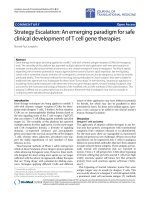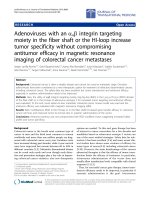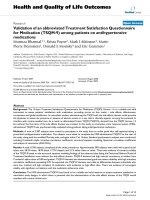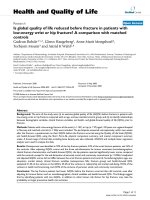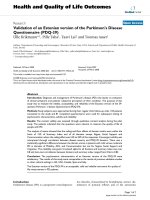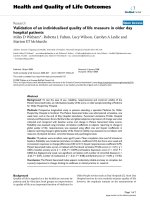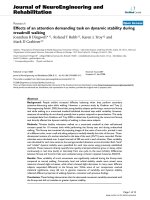báo cáo hóa học:" Is there an association between PEPFAR funding and improvement in national health indicators in Africa? A retrospective study" pdf
Bạn đang xem bản rút gọn của tài liệu. Xem và tải ngay bản đầy đủ của tài liệu tại đây (694.01 KB, 9 trang )
Duber et al. Journal of the International AIDS Society 2010, 13:21
/>Open Access
RESEARCH
© 2010 Duber et al; licensee BioMed Central Ltd. This is an Open Access article distributed under the terms of the Creative Commons
Attribution License ( which permits unrestricted use, distribution, and reproduction in
any medium, provided the original work is properly cited.
Research
Is there an association between PEPFAR funding
and improvement in national health indicators in
Africa? A retrospective study
Herbert C Duber*
1,2,3
, Thomas J Coates
3
, Greg Szekeras
3
, Amy H Kaji
1,2,3
and Roger J Lewis
1,2,3
Abstract
Background: The US President's Emergency Plan for AIDS Relief (PEPFAR) was reauthorized in June 2008 with a three-
fold increase in funds, and a broader, more explicit mandate to improve health in the low- and middle-income
countries that it funded. However, the ability of a disease-specific, or vertical, programme to have a spill-over effect and
improve health outcomes has been questioned. In this study, we sought to examine associations between being
designated as a PEPFAR focus country (and receiving increased PEPFAR funding) and non-HIV-specific health outcomes
in the World Health Organization (WHO) Africa Region, the area most affected by the HIV/AIDS epidemic.
Methods: A retrospective analysis of publicly available health outcomes data published by the World Health
Organization was performed for all countries in the WHO Africa Region. Fractional changes in health indicators
between 2000 and 2006 were calculated, and PEPFAR focus and non-focus countries were then compared.
Results: Overall, countries in the WHO Africa Region showed a small worsening in health outcomes status when all
indicators were analyzed together and weighted equally. However, more health indicators improved than worsened
over this six-year period. A comparison of PEPFAR focus and non-focus countries found no significant difference in the
fractional change among 13 of 14 health indicators during the study period.
Conclusions: This study suggests that vertical programmes, even one that is the scale of PEPFAR, may have little or no
impact on health outcomes not explicitly targeted.
Background
The HIV/AIDS epidemic has taken a substantial toll
worldwide. Yet nowhere is the effect of this disease felt
more deeply than in sub-Saharan Africa, where nearly
two-thirds of the estimated 33 million people worldwide
infected with HIV live [1]. As part of the global response
to HIV, there has been a significant increase in funding to
low- and middle-income countries to strengthen treat-
ment, prevention and research programmes [2,3]. Nearly
US$10 billion in funding was earmarked in 2008 for HIV/
AIDS in low- and middle-income countries, representing
an approximate 20-fold increase from a decade ago [2].
The largest effort by a single government to combat
HIV/AIDS, the President's Emergency Plan for AIDS
Relief (PEPFAR) was first authorized by the United States
Congress and signed into law in 2003 with a budget of
US$15 billion over five years. Fifteen focus countries, 12
of them in sub-Saharan Africa, were chosen as beneficia-
ries of two-thirds of the PEPFAR funds [4]. PEPFAR's
five-year performance targets for the focus countries
were to support prevention of seven million HIV infec-
tions, treat two million people with HIV/AIDS with anti-
retroviral therapy, and care for 10 million people infected
with and affected by HIV/AIDS, including orphans and
other vulnerable children [5].
In its 2008 report to Congress, the Office of the United
States Global AIDS Coordinator (OGAC) reported that
many of these goals were close to being met [6]. On 30
June 2008, the President of the United States, with the
consent of Congress, reauthorized PEPFAR for five more
years, increasing the budget between 2008 and 2013 to
more than US$48 billion [7].
* Correspondence:
1
Department of Emergency Medicine, Harbor-UCLA Medical Center, Torrance,
California, USA
Full list of author information is available at the end of the article
Duber et al. Journal of the International AIDS Society 2010, 13:21
/>Page 2 of 9
An increasing number of published studies have sup-
ported the successes of PEPFAR. There has been a well-
documented increase in individuals receiving HIV care in
locations receiving PEPFAR funding [8], and several stud-
ies have suggested local decreases in mortality where HIV
services have been scaled up [9,10]. Most recently, Ben-
david and Bhattacharya [11] demonstrated that PEPFAR
focus countries appear to be doing significantly better
than non-focus countries when analyzing HIV-specific
health outcomes, including HIV-related mortality and
persons living with HIV. However, the question as to
whether PEPFAR has had meaningful impact on the
broader health care system remains unanswered.
In addition to the three primary goals of HIV preven-
tion, treatment and support, the PEPFAR programme,
particularly its reauthorization, also aims to increase
health care capacity and reform in countries receiving
PEPFAR funds [4,12,13]. This is of utmost importance as
most middle- and low-income countries, such as the 15
PEPFAR focus countries, suffer from inadequate health
sector supplies, infrastructure and human resources
[14,15]. While many disease-specific (otherwise known
as vertical) programmes have been successful in yielding
improved outcomes related to the disease entities they
are designed to address [16,17], they are often not nearly
as effective in changing policy and reforming health sys-
tems [18,19].
Furthermore, many authors have argued that vertical
programmes do not improve, and can actually harm, the
overall health status of a population. It has been postu-
lated that vertical programmes: (1) do not produce signif-
icant spillover in terms of additional resources for
addressing other diseases and/or programmes within the
health care sector [20]; (2) may displace funding
resources from other important programmes [21]; and
(3) can create an internal "brain drain" by diverting intel-
lectual resources and human capacity from lower paying
government jobs to higher paying vertical programme
positions [22]. As a result, the World Health Organiza-
tion (WHO) has instead advocated for an alternative
approach that funds health care through a sector-wide
approach[14].
A sector-wide approach represents a nationally based
effort to increase health sector coordination, national
leadership and ownership, and strengthen countrywide
management and health care delivery systems [18]. In
theory, such an approach reduces duplication of efforts,
lowers transaction costs, increases equity and sustainabil-
ity, and improves aid effectiveness and health sector effi-
ciency [23]. However, for donor organizations and
governments, a sector-wide approach is often less attrac-
tive because countries receiving funds are prioritizing
programme funding based on a national health strategy,
rather than on the donors' interests. This results in signif-
icantly less donor control when compared with tradi-
tional bilateral funding mechanisms.
In a 2007 report, the Institute of Medicine (IOM), the
body charged with monitoring PEPFAR, expressed the
possibility that a vertical programme, such as PEPFAR,
can improve overall national health [24]. The report
stated that explicit intervention priorities, such as HIV/
AIDS, can be used to drive desired improvements into
the health system [24]. This same position - that the scale
up of HIV care and treatment, if designed and imple-
mented appropriately, can have broad health benefits -
was taken by El-Sadr and Abrams [25]. They make the
logical argument that with such large sums of money
being directed towards HIV, it would be necessary to
improve infrastructure, expand the health care workforce
and strengthen health systems, leading to improved
health outcomes more broadly.
However, there is no evidence to date suggesting that
PEPFAR has yielded any significant changes in overall
mortality or other national health indicators that are not
explicitly HIV related [26]. This is a critical gap in our
understanding of the effects of this programme. The IOM
report states that the "benefits and unintended conse-
quences [of PEPFAR] will not be fully appreciated if the
initiative is evaluated only with respect to HIV/AIDS tar-
gets Measures of this impact need to include work-
force and infrastructure, as well as other health
outcomes, such as infant mortality and all cause mortal-
ity" [24].
The purpose of this study is to assess the association
between PEPFAR funding and changes in a broad range
of health indicators among 46 countries in the WHO
African Region.
Methods
Study type
This study was a retrospective analysis of publicly avail-
able health indicators from 46 African countries.
Data source
PEPFAR focus countries were identified based on their
designation by the Office of the United States Global
AIDS Coordinator
. The WHO
Statistical Information System (WHOSIS) was utilized as
the sole data source. All data are publicly available
through the WHO website />data/Search.jsp.
Data collection
Data collection was completed in September 2008. A
search of health indicators by year was performed using
the WHOSIS database for all countries within the WHO
Africa Region. Socio-economic and demographic indica-
tors were excluded from the initial database search. All
Duber et al. Journal of the International AIDS Society 2010, 13:21
/>Page 3 of 9
indicators related to mortality, morbidity, human
resources, access to care and health resources from the
years 2000 and 2006 were selected as these were the two
years in which data were available. Indicators were fur-
ther limited by sex: when male, female and both sexes
were included as separate indicators, only "both sexes"
was included in the final analysis. Twelve additional indi-
cators that dealt purely with health care financing were
eliminated.
Data analysis
Data was compiled onto an Excel spreadsheet (Microsoft
Excel, Microsoft Corporation, Redmond, WA) and trans-
lated into a native SAS format using DBMS/Copy
®
(Data-
flux Corporation, Cary, NC). Analyses were conducted
using SAS version 9.1 (SAS Institute, Cary, NC). Descrip-
tive statistics were calculated for all indicators. When
appropriate, numerical variables were compared using
the non-parametric Wilcoxon rank sum test or the non-
parametric signed-rank test, and are reported as medians
with interquartile ranges (IQRs). No adjustment was
made for multiple comparisons.
Countries were divided into PEPFAR focus and non-
focus countries. Using the year 2000 as the baseline com-
parator, a fractional change was calculated for each indi-
cator in each country across the WHO Africa Region.
This allowed each country to serve as its own baseline
control. A negative fractional change indicates an
improvement in a given indicator (e.g., a decrease in mor-
tality). Likewise, a positive fractional change suggests a
worsening health indicator (e.g., an increase in tuberculo-
sis prevalence).
To be consistent with this definition, the fractional
change for the following health indicators were reversed
(a negative value was made positive and vice versa): life
expectancy at birth; neonates protected at birth against
neonatal tetanus; one year olds immunized with menin-
gococcal conjugate vaccine (MCV); one year olds immu-
nized with three doses of diphtheria, tetanus and
pertussis (DTP) vaccine; population with sustainable
access to improved drinking water sources; population
with sustainable access to improved sanitation; and TB
detection rate under directly observed treatment, short
course (DOTS). For example, the life expectancy in
Rwanda between 2000 and 2006 increased from 46 to 52
years. The fractional change is calculated at 0.13, but
changed to -0.13 to reflect an improvement.
A second analysis comparing PEPFAR focus and non-
focus countries was performed utilizing a slightly differ-
ent set of 29 non-focus countries in order to maintain
some consistency with the recently published work of
Bendavid and Bhattacharya [11].
Study approval
The study was approved as exempt by the Human Sub-
jects Committee (IRB) of the Los Angeles Biomedical
Research Institute at Harbor-UCLA Medical Center.
Results
The WHO Africa Region is comprised of 46 countries, 12
of which were given PEPFAR focus country designation
by the Office of the United States Global AIDS Coordina-
tor. The remaining 34 are non-focus countries. One hun-
dred and forty-nine health indicators were found in the
initial database search, most of which were missing data
points. Of the indicators with complete or nearly com-
plete data sets, 14 met inclusion criteria as defined in the
Methods section.
WHO Africa Region
Figure 1 (composite graph) represents the fractional
change in all utilized health indicators across all countries
in the WHO Africa Region. Although a visual inspection
reveals no clear trend towards improving or worsening
health indicators within the region as a whole, a statistical
analysis shows a modest, but statistically significant 3.5%
average worsening over all health indicators.
However, when each indicator is analyzed indepen-
dently (Figure 2), it appears that most are actually
improving. In fact, nine of the 14 health indicators have a
negative median value and eight of these are statistically
significant (Table 1). The range of improvement varies
from a 1.6% fractional improvement in life expectancy at
birth to a 19.7% gain in neonates protected at birth (PAB)
against neonatal tetanus. The remaining five indicators
all have a median fractional change that may indicate
some worsening in the health indicator, but none are sta-
tistically significant.
Comparison by PEPFAR focus country designation
A comparison of PEPFAR focus countries with the non-
focus countries is found in Table 2. Eleven of the 14
health indicators have negative median values among the
PEPFAR focus country group, and eight of the 14 health
indicators have negative median values among the non-
focus group. Yet, when we compare the PEPFAR focus
countries and the non-focus countries, a non-significant
p value is noted among all of the health indicators, with
the exception of neonates PAB against neonatal tetanus.
Although both focus and non-focus countries showed
fractional improvement in neonates PAB against neonatal
tetanus, the non-focus countries actually performed sig-
nificantly better than the PEPFAR focus countries (p
value 0.011). A second analysis utilized the 29 non-focus
countries found in the Bendavid and Bhattacharya paper
and resulted in a similar trend.
Duber et al. Journal of the International AIDS Society 2010, 13:21
/>Page 4 of 9
Country-level results
A country-level analysis utilizing all 14 health indicators
can be found in Table 3 (PEFPFAR focus countries) and
Table 4 (non-focus countries). Among PEPFAR focus
countries, all except for South Africa seemed to be trend-
ing towards improvement with a negative median frac-
tional change. Four of these countries (Kenya, Uganda,
Tanzania and Zambia) had statistically significant
improvements ranging from 8.5% to 5.1%.
In the non-focus country group, 25 countries have neg-
ative median values and nine positive median values.
Eight countries demonstrate statistically significant
improvements (Angola, Cameroon, Comoros, Gambia,
Malawi, Mali, Sao Tome and Principe, and Togo) with
medians ranging from 17.1% to 4.5%; two (Equitorial
Guinea and Swaziland) have statistically significant wors-
ening with fractional changes ranging from 8.6% to 3.3%.
Discussion
To our knowledge, this is the first study to compare PEP-
FAR focus and non-focus countries, using non-HIV-spe-
cific national health indicators, since the inception of the
programme. An initial glance at the data suggests that
PEPFAR focus and non-focus countries are performing
similarly with regard to multiple health indicators. While
overall, most countries in the WHO Africa Region appear
to be improving, the pace of improvement is nearly the
same in both PEPFAR focus and non-focus countries.
If PEPFAR was designed as a vertical programme with
no intention to improve health on a broader scale, our
findings could reflect the fact that HIV is not the leading
cause of mortality, or that HIV does not represent a large
burden of disease in many of these countries (e.g.,
approximately 2.1% and 3.1% of the population is infected
with HIV in PEPFAR focus countries Ethiopia and
Rwanda, respectively) [2]. As a result, even a significant
effect on HIV mortality (and HIV-associated health indi-
cators in general) might not be noticeable in a general
population analysis.
Using that same logic, however, we would expect to see
potentially large gains in broad categories, such as all-
cause mortality (infant, child and adult), vaccination
rates, and decreasing incidence of highly prevalent dis-
eases (e.g., tuberculosis) in countries with high HIV prev-
alence rates. Interestingly enough, South Africa, where
the HIV prevalence rate is 18.8%, is the only PEPFAR
focus country with a median value that would seem to
indicate an overall worsening of health care indicators
(although not statistically significant).
As clearly stated by the OGAC and the IOM, PEPFAR
strives to not only improve HIV prevention, treatment
and care, but also to improve the health system as a
Figure 1 Graphical Display of fractional changes in all reported health indicators for each PEPFAR focus and non-focus country. Improve-
ments in health indicators are indicated by negative fractional changes (see text).
Non-focus
Country
Algeria
Angola
Benin
Burkina Faso
Burundi
Cameroon
Cape Verde
Central African Republic
Chad
Comoros
Congo
Democratic Republic of the Congo
Equatorial Guinea
Eritrea
Gabon
Gambia
Ghana
Guinea
Guinea-Bissau
Lesotho
Liberia
Madagascar
Malawi
Mali
Mauritania
Mauritius
Niger
Sao Tome and Principe
Senegal
Seychelles
Sierra Leone
Swaziland
Togo
Zimbabwe
Fraction change 2000 to 2006
-1.5
-1.0
-0.5
0.0
0.5
1.0
1.5
Focus
Botswana
Cote d'Ivoire
Ethiopia
Kenya
Mozambique
Namibia
Nigeria
Rwanda
South Africa
Uganda
United Republic of Tanzania
Zambia
Duber et al. Journal of the International AIDS Society 2010, 13:21
/>Page 5 of 9
Figure 2 Graphical display of fractional changes in each of the 14 health indicators considered, with each plotted point representing a sin-
gle country. As in Figure 1, countries to the left of the vertical line in each panel are non-focus countries and those to the right of the line are PEPFAR
focus countries. The health indicators are: (a) adult mortality rate; (b) deaths due to TB among HIV-negative people; (c) deaths due to TB among HIV-
positive people; (d) incidence of TB; (e) infant mortality rate; (f) life expectancy at birth; (g) neonates PAB against neonatal tetanus; (h) one year olds
immunized with MCV; (i) one-year-olds immunized with three doses of DTP; (j) population with sustained access to improved drinking water; (k) pop-
ulation with sustained access to improved sanitation; (l) prevalence of TB; (m) TB detection rate under DOTS; and (n) under-five mortality rate
Fractoinal change
-1.5
-1.0
-0.5
0.0
0.5
1.0
1.5
Fractional change
-1.5
-1.0
-0.5
0.0
0.5
1.0
1.5
Fractional change
-1.5
-1.0
-0.5
0.0
0.5
1.0
1.5
-1.5
-1.0
-0.5
0.0
0.5
1.0
1.5
Fractional change
-1.5
-1.0
-0.5
0.0
0.5
1.0
1.5
-1.5
-1.0
-0.5
0.0
0.5
1.0
1.5
Fractional change
-1.5
-1.0
-0.5
0.0
0.5
1.0
1.5
-1.5
-1.0
-0.5
0.0
0.5
1.0
1.5
-1.5
-1.0
-0.5
0.0
0.5
1.0
1.5
Fractional change
-1.5
-1.0
-0.5
0.0
0.5
1.0
1.5
-1.5
-1.0
-0.5
0.0
0.5
1.0
1.5
-1.5
-1.0
-0.5
0.0
0.5
1.0
1.5
Fractional change
-1.5
-1.0
-0.5
0.0
0.5
1.0
1.5
-1.5
-1.0
-0.5
0.0
0.5
1.0
1.5
AB
CD
EF
H
J
G
L
N
I
K
M
Non-focus Non-focusFocus Focus
Duber et al. Journal of the International AIDS Society 2010, 13:21
/>Page 6 of 9
whole, by boosting infrastructure, training and supplies,
and increasing public confidence in the health care sys-
tem of many developing countries [4,24]. The WHO data
we have analyzed, which incorporates the first three years
of the PEPFAR programme (2003 to 2006), indicates that
PEPFAR may not yet be successful in achieving the latter
goals.
On the other hand, we do not see any evidence of PEP-
FAR having a deleterious effect. If supplies, attention and
task shifting were employed in a way that resulted in
decreased rates of immunization, clinic staffing or health
care resources, we might expect to see a trend towards
worsening non-HIV-specific health indicators. In fact,
our analysis shows that 11 of the 12 PEPFAR focus coun-
tries are actually moving in the right direction with
respect to multiple health indicators.
We must also question whether PEPFAR might actually
be an effective approach to HIV/AIDS in Africa and, if so,
why we might obtain the results presented here. First, has
there been enough time for PEPFAR to make a differ-
ence? The 2006 data from WHO was likely collected early
in the year (if not in 2005), and PEPFAR, although it was
started in 2003, was not in full operational force until
2004. There may not have been adequate time for allo-
cated monies to have reached the local agencies.
Second, it is possible that the monetary sum repre-
sented by PEPFAR, although very large, is still not
enough. In low-income countries, like those in the WHO
Africa Region, billions of dollars may still not be enough
when dealing with such large deficits in health care infra-
structure, personnel and resources.
Third, perhaps money is not the driving factor for
change. Additional factors, such as political corruption,
poor utilization of resources, problems with aid disburse-
ment, lack of education, and a "donor-driven" rather than
"owner-driven" agenda, may be obstacles too significant
to overcome even with significant sums of money.
This study should be seen as a step in the overall evalu-
ation of PEPFAR. A more comprehensive re-evaluation,
using similar, and preferably many more, health indica-
tors after several more years of the programme, would be
an appropriate next step. It is important that outcomes,
such as hospitalization, morbidity and mortality, are uti-
lized in future analyses, including IOM PEPFAR evalua-
tions. While the goals set for antiretroviral therapy and
caring for those infected with HIV provide important
early markers, and aid in the motivation of staff, true out-
come data will determine the success of this programme
and answer the question of whether a vertical programme
can have broader effects on public health.
Limitations
While the data that we have presented represents the best
publicly available information we are aware of, we note
that many data points were unchanged between 2000 and
2006. The lack of any apparent change over this six-year
Table 1: Overall changes in health indicators in the WHO Africa Region
Health indicator Median fractional change* p value+
Adult mortality rate -0.007 (-0.064, 0.069) 0.919
Deaths due to TB, HIV negative 0.008 (-0.087, 0.162) 0.204
Deaths due to TB, HIV positive 0.000 (-0.135, 0.333) 0.112
Incidence of TB 0.137 (-0.028, 0.155) < 0.001
Infant mortality rate -0.052 (-0.115, 0.000) 0.002
Life expectancy at birth -0.016 (-0.035, 0.000) 0.035
Neonates PAB against neonatal tetanus -0.197 (-0.428, -0.063) < 0.0001
One year olds immunized with MCV -0.143 (-0.431, 0.000) < 0.0001
One year olds immunized with 3 doses of DTP -0.142 (-0.455, -0.012) < 0.0001
Population with sustainable access to improved drinking water sources -0.031 (-0.111, 0.000) < 0.0001
Populations with sustainable access to improved sanitation -0.071 (-0.148, 0.000) < 0.0001
Prevalence of TB 0.046 (-0.074, 0.153) 0.180
TB detection rate under DOTS 0.000 (-0.156, 0.045) 0.111
Under-5 mortality rate -0.064 (-0.130, 0.000) 0.001
All indicators 0.035 (-0.042, 0.156) < 0.0001
* Each fractional change is normalized to the reported value in 2000. Values are shown as medians with interquartile ranges (IQRs). The
number of countries in the region reporting each health indicator varies from 43 to 46.
+
The p value addresses the question of whether the observed fractional change is statistically significantly different than zero, as assessed
by the Wilcoxon signed rank test.
Duber et al. Journal of the International AIDS Society 2010, 13:21
/>Page 7 of 9
period may be accurate, or it may reflect a lack of data
quality, or even a country simply reporting old numbers
to address newly requested data points in the absence of
new information. It is likely very difficult to conduct an
accurate national survey for many of these health indica-
tors, especially in developing countries. It is unclear
whether PEPFAR focus and non-focus countries face
similar challenges in data collection, or what bias is likely
to result from poor data collection procedures.
In addition, this study does not account for non-PEFAR
health sector foreign assistance, and does not try to quan-
tify what would have happened without PEPFAR assis-
tance in focus countries. Non-PEPFAR health sector
funding may have a significant impact in both PEPFAR
focus and non-focus countries, but in this study we did
not attempt to quantify the amount or effect of non-PEP-
FAR funding.
While it is true that specific PEPFAR-funded care
surely saves some individual lives, our results failed to
demonstrate an inter-country association between PEP-
FAR funding and a variety of health status indicators.
One possible explanation is that health indicators might
have fallen without PEPFAR funding. However, such a fall
was not observed in the non-PEPFAR-funded countries,
so we were unable to find empirical support for that
explanation.
Another limitation in the available data is the small
number of health indicators and the utilization of only
two time periods. Ideally, we would like to use a richer set
of health indicators, representing a wider variety of dis-
ease processes, health care services and encounters, and
public health processes. The availability of only two mea-
surements for each indicator is also a significant limita-
tion. While we calculated a fractional change, there is no
way to know how that change occurred during the six-
year period from 2000 to 2006. The use of more high-fre-
quency measurements would be highly beneficial for
ongoing evaluations of the PEPFAR programme, and
something that PEPFAR money should potentially sup-
port.
Table 2: Comparison of changes in health indicators in PEPFAR focus and non-focus countries
Health indicator Fractional change from 2000 to 2006* p value**
PEPFAR focus countries† Non-focus countries‡
Adult mortality rate -0.029 (-0.111, 0.046) 0.002 (-0.058, 0.069) 0.348
Deaths due to TB, HIV negative 0.057 (-0.048, 0.178) 0.000 (-0.111, 0.146) 0.576
Deaths due to TB, HIV positive -0.109 (-0.220, 0.236) 0.050 (-0.037, 0.333) 0.139
Incidence of TB 0.153 (-0.082, 0.156) 0.137 (0.012, 0.155) 0.920
Infant mortality rate -0.079 (-0.139, 0.013) -0.041 (-0.108, 0.000) 0.616
Life expectancy at birth -0.021 (-0.048, 0.000) -0.007 (-0.035, 0.019) 0.187
Neonates PAB against neonatal tetanus -0.099 (-0.157, -0.037) -0.328 (-0.486, -0.078) 0.011
One year olds immunized with MCV -0.094 (-0.248, 0.000) -0.157 (-0.490, 0.000) 0.507
One year olds immunized with 3 doses of DTP -0.085 (-0.269, -0.042) -0.173 (-0.578, -0.010) 0.460
Population with sustainable access to improved drinking
water sources
-0.060 (-0.130, -0.017) -0.022 (-0.111, 0.000) 0.367
Populations with sustainable access to improved
sanitation
-0.053 (-0.092, -0.028) -0.085 (-0.207, 0.000) 0.597
Prevalence of TB 0.064 (-0.066, 0.162) 0.038 (-0.079, 0.153) 0.851
TB detection rate under DOTS -0.056 (-0.190, 0.072) 0.000 (-0.097, 0.000) 0.659
Under-5 mortality rate -0.077 (-0.144, 0.017) -0.038 (-0.130, 0.000) 0.698
All indicators 0.038 (-0.073, 0.148) 0.033 (-0.033, 0.167) 0.301
* Each fractional change is normalized to the reported value in 2000. Values are shown as medians with interquartile ranges (IQRs).
† PEPFAR focus countries are Botswana, Cote d'Ivoire, Ethiopia, Kenya, Mozambique, Namibia, Nigeria, Rwanda, South Africa, Uganda, United
Republic of Tanzania, Zambia. All PEPFAR focus countries reported each of the above health indicators.
‡ The non-focus countries are Algeria, Angola, Benin, Burkina Faso, Burundi, Cameroon, Cape Verde, Central African Republic, Chad,
Comoros, Congo, Democratic Republic of the Congo, Equatorial Guinea, Eritrea, Gabon, Gambia, Ghana, Guinea, Guinea-Bissau, Lesotho,
Liberia, Madagascar, Malawi, Mali, Mauritania, Niger, Sao Tome and Principe, Senegal, Seychelles, Sierra Leone, Swaziland, Togo, Zimbabwe.
The number of non-focus countries reporting each health indicator varies from 31 to 34.
** The p value addresses the question of whether the median fractional change for each health indicator is statistically significantly different
in PEPFAR focus and non-focus countries, as assessed by the Wilcoxon rank sum test.
Duber et al. Journal of the International AIDS Society 2010, 13:21
/>Page 8 of 9
Finally, because of difficulty defining the relative impor-
tance of different health outcomes, all health indicators
(and all countries) were weighted equally in the statistical
analysis. This means, for example, that adult mortality
rate was given equal importance to one year olds immu-
nized with meningococcal conjugate vaccine. Similarly, a
large country, South Africa with a population of 47.9 mil-
lion, was given equal weight to Sao Tome and Principe,
with its population of just over 200,000 [27]. However, to
partially address this limitation, all analyses were further
stratified by country and by health indicator.
Conclusions
PEPFAR represents the largest single government effort
to combat HIV/AIDS worldwide. Although its primary
goals are HIV related, its secondary goals of improving
health care resources, infrastructure and workforce as a
means of improving overall health are much broader, and
perhaps more important. However, our analysis of avail-
able WHO health indicators between 2000 and 2006
demonstrates no significant difference in improvement in
PEPFAR focus countries when compared with non-focus
countries. Further studies will be necessary to detect the
association, if one exists, between PEPFAR funding and
non-HIV-specific health outcomes.
Table 3: Changes in health indicators among PEPFAR focus
countries
Country Median fractional change*
p value+
Botswana -0.035 (-0.067, 0.000) 0.569
Cote d'Ivoire -0.026 (-0.080, 0.147) 0.677
Ethiopia -0.145 (-0.212, 0.100) 0.091
Kenya -0.080 (-0.117, -0.024) 0.003
Mozambique -0.034 (-0.148, 0.033) 0.358
Namibia -0.018 (-0.100, 0.063) 0.455
Nigeria -0.030 (-0.077, 0.088) 0.583
Rwanda -0.048 (-0.126, 0.154) 0.946
South Africa 0.108 (-0.074, 0.291) 0.135
Uganda -0.085 (-0.257, 0.044) 0.035
Republic of Tanzania -0.065 (-0.159, -0.020) 0.005
Zambia -0.051 (-0.154, 0.000) 0.002
* Each fractional change is normalized to the reported value in 2000.
Values are shown as medians with interquartile ranges (IQRs). The
number of health indicators reported by each country varies from 13
to 14.
+
The p value addresses the question of whether the observed
fractional change is statistically significantly different than zero, as
assessed by the Wilcoxon signed rank test.
Table 4: Changes in health indicators among PEPFAR non-
focus counties
Country Median fractional change* p value+
Algeria -0.018 (-0.111, 0.045) 0.891
Angola -0.099 (-0.396, 0.000) 0.019
Benin -0.031 (-0.080, 0.000) 0.110
Burkina Faso 0.026 (-0.286, 0.235) 1.000
Burundi 0.000 (-0.021, 0.024) 0.945
Cameroon -0.171 (-0.481, -0.011) 0.020
Cape Verde 0.000 (-0.178, 0.012) 0.244
Central African
Republic
-0.045 (-0.141, 0.000) 0.077
Chad 0.049 (0.016, 0.175) 0.497
Comoros -0.120 (-0.207, 0.014) 0.027
Congo 0.034 (-0.059, 0.407) 0.622
Democratic Republic
of the Congo
-0.022 (-0.271, 0.095) 0.204
Equitorial Guinea 0.033 (0.000, 0.153) 0.004
Eritrea -0.076 (-0.213, 0.141) 0.542
Gabon 0.000 (-0.024, 0.033) 1.000
Gambia -0.051 (-0.136, 0.000) 0.024
Ghana -0.030 (-0.111, 0.017) 0.186
Guinea -0.087 (-0.188, 0.291) 0.502
Guinea-Bissau -0.019 (-0.100, 0.017) 0.267
Lesotho 0.094 (-0.059, 0.160) 0.268
Liberia -0.008 (-0.412, 0.000) 0.131
Madagascar -0.054 (-0.091, 0.000) 0.257
Malawi -0.108 (-0.200, -0.048) 0.002
Mali -0.045 (-0.529, -0.028) 0.008
Mauritania -0.006 (-0.091, 0.000) 0.275
Mauritius -0.035 (-0.102, 0.000) 0.232
Niger -0.056 (-0.246, 0.064) 0.268
Sao Tome and
Principe
-0.074 (-0.133, -0.008) 0.004
Senegal -0.053 (-0.128, 0.134) 0.588
Seychelles -0.006 (-0.071, 0.000) 0.219
Sierra Leone -0.022 (-0.127, 0.331) 0.903
Swaziland 0.086 (-0.017, 0.176) 0.043
Togo -0.045 (-0.333, 0.009) 0.043
Zimbabwe -0.035 (-0.135, 0.044) 0.194
* Each fractional change is normalized to the reported value in 2000.
Values are shown as medians with interquartile ranges (IQRs). The
number of health indicators reported by each country varies from 11
to 14.
+
The p value addresses the question of whether the observed
fractional change is statistically significantly different than zero, as
assessed by the Wilcoxon signed rank test.
Duber et al. Journal of the International AIDS Society 2010, 13:21
/>Page 9 of 9
Competing interests
The authors declare that they have no competing interests.
Authors' contributions
HD, TC, GS, and RL were involved in the development of the study concept. HD,
TC and RL worked on study design. HD performed data collection. AK and RL
assisted with data analysis. HD created the manuscript, with editing and revi-
sion by AK, TC and RL. All authors reviewed and agree with the findings in the
final manuscript.
Author Details
1
Department of Emergency Medicine, Harbor-UCLA Medical Center, Torrance,
California, USA,
2
Los Angeles Biomedical Research Institute, Torrance, California,
USA and
3
Department of Medicine, David Geffen School of Medicine at UCLA,
Los Angeles, California, USA
References
1. UNAIDS: Report on the Global AIDS Epidemic. Geneva: UNAIDS; 2008.
2. Cohen J: The Great Funding Surge. Science 2008, 321:512-519.
3. Kates J, Morrison JS, Lief E: Global health funding: a glass half full? The
Lancet 2006, 368:187-188.
4. Office of the United States Global AIDS Coordinator: The President's
Emergency Plan for AIDS Relief. US Global Five Year HIV/AIDS Strategy.
Washington, DC; 2004.
5. United States Leadership Against HIV/AIDS, Tuberculosis, and Malaria Act
of 2003: US Public Law; 2003:108-25. 117 Stat. 711
6. Office of the United States Global AIDS Coordinator: The Power of
Partnerships: The U.S. President's Emergency Plan for AIDS Relief. In
2008 Annual Report to Congress Washington, DC; 2008.
7. Gostin LO: President's Emergency Plan for AIDS Relief: Health
Development at the Crossroads. JAMA 2008, 300:2046-2048.
8. Wools-Kaloustian K, Kimaiyo S, Musick B, Sidle J, Siika A, Nyandiko W,
Einterz R, Tierney WM, Yiannoutsos CT: The impact of the President's
Emergency Plan for AIDS Relief on expansion of HIV care services for
adult patients in western Kenya. AIDS 2009, 23:195-201.
9. Jahn A, Floyd S, Amelia CC, Mwaungulu F, Mvula H, Munthali F, McGrath
N, Mwafilaso J, Mwinuka V, Mangongo B, Fine PE, Zaba B, Glynn JR:
Population-level effect of HIV on adult mortality and early evidence of
reversal after introduction of antiretroviral therapy in Malawi. Lancet
2008, 371:1603-1611.
10. Price JE, Leslie JA, Welsh M, Binagwaho A: Integrating HIV clinical
services into primary health care in Rwanda: a measure of quantitative
effects. AIDS Care 2009, 21:608-614.
11. Bendavid E, Bhattacharya J: The President's Emergency Plan for AIDS
Relief in Africa: An Evaluation of Outcomes. Ann Intern Med 2009,
150:688-695.
12. El-Sadr WM, Hoos D: The President's Emergency Plan for AIDS Relief - Is
the Emergency Over? The New England Journal of Medicine 2008,
359:553-555.
13. Office of the United States Global AIDS Coordinator: The U.S. President's
Emergency Plan for AIDS Relief. 2009 Annual Report to Congress.
Washington, DC; 2009. Celebrating Life
14. World Health Organization: The World Health Report 2000 - Health
systems: improving performance. Geneva; World Health Organization;
2000.
15. Horton R: Development aid: manna or myth? The Lancet 2000,
356:1044-1045.
16. Barquet N, Domingo P: Smallpox: the triumph over the most terrible of
the ministers of death. Annals of Internal Medicine 1997, 127:635-642.
17. Frieden TR: Lessons from tuberculosis control from public health.
International Journal of Tuberculosis and Lung Disease 2009, 13:421-428.
18. Peters D, Chao S: The sector-wide approach in health: What is it? Where
is it leading? The International Journal of Health Planning and
Management 1998, 13:177-190.
19. Nixon S, Veenstra N: The impact of ART (anti-retroviral treatment) scale-
up on health systems de-strengthening in sub-Saharan Africa: justice
and justification. Med Law 2008, 27:685-703.
20. Segall M: District health systems in a neoliberal world: a review of five
key policy areas. International Journal of Health Planning and
Management 2003, 18:S5-S26.
21. Shiffman J: Has donor prioritization of HIV/AIDS displaced aid for other
health issues? Health Policy and Planning 2008, 23:95-100.
22. De Maeseneer J, van Weel C, Wgilman D, Mfenyana K, Kaufman A,
Sewankambo N, Flinkenflögel M: Funding for primary health care in
developing countries. British Medical Journal 2008, 336:518-519.
23. Tanner M, Hutton G: The sector-wide approach: a blessing for public
health? Bulletin of the WHO 2004, 82:893.
24. Sepulveda J, Carpenter C, Curran J, Holzemer W, Smits H: PEPFAR
Implementation: Progress and Promise. Washington, DC: National
Academies Press; 2007.
25. El-Sadr WM, Abrams EJ: Scale-up of HIV care and treatment: can it
transform healthcare services in resource-limited settings? AIDS 2007,
21(suppl 5):S65-S70.
26. Gross R, Bisson GP: Evaluating the President's Emergency Plan for AIDS
Relief: Time to Scale It Up. Annals of Internal Medicine 2009, 150:727-728.
27. US Department of State: Background Notes. [ />pa/ei/bgn/index.htm]. Accessed 3 March 3 2009
doi: 10.1186/1758-2652-13-21
Cite this article as: Duber et al., Is there an association between PEPFAR
funding and improvement in national health indicators in Africa? A retro-
spective study Journal of the International AIDS Society 2010, 13:21
Received: 10 February 2010 Accepted: 12 June 2010
Published: 12 June 2010
This article is available from: 2010 Duber et al; licensee BioMed Central Ltd. This is an Open Access article distributed under the terms of the Creative Commons Attribution License ( ), which permits unrestricted use, distribution, and reproduction in any medium, provided the original work is properly cited.Journal of th e Internatio nal AIDS Societ y 2010, 13:21

